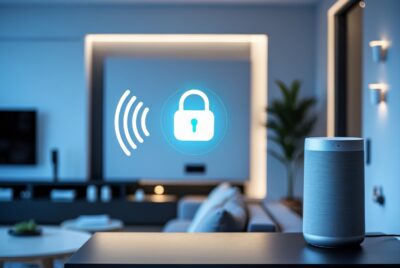Ecobee Smart Sensor Benefits: Enhancing Home Efficiency
*We may earn a commission for purchases made using our links. Please see our disclosure to learn more.
Ecobee Smart Sensor Benefits: Enhancing Home Comfort and Efficiency
Smart home technology has revolutionized how we interact with the devices in our living spaces, offering convenience, energy efficiency, and enhanced security. At the heart of this transformation are smart sensors, small but powerful gadgets capable of detecting a variety of environmental conditions and responding accordingly. Among these, the Ecobee Smart Sensor stands out for its integration with the broader Ecobee ecosystem, which centers around smart thermostats designed to optimize home comfort and energy usage.
As a temperature and occupancy detector, the Ecobee Smart Sensor enables personalized heating and cooling by adjusting the room’s environment based on presence and preference. This intelligent functionality not only enhances comfort but can also lead to significant savings on energy bills. These sensors are tailor-made for individuals who seek to streamline their home’s climate control without constant manual adjustments.
When choosing a smart sensor, key considerations should include compatibility with your existing smart home system, the sensor’s range and sensitivity, battery life, and how it communicates with other smart devices. For instance, the Ecobee Smart Sensor pairs seamlessly with Ecobee thermostats and offers long-lasting battery life, which is crucial for maintaining consistent performance without frequent maintenance.
After years of personal experience and research into smart home products, I appreciate the Ecobee Smart Sensor’s role in creating a more intuitive and comfortable living environment. Its thoughtful design and features make it a worthwhile consideration for anyone looking to upgrade their home automation setup. As we proceed, I’ll explore the intricacies of the Ecobee Smart Sensor to help you make an informed decision.
Top Ecobee Smart Sensors
In my search for the most efficient ways to improve home automation and energy management, I’ve found that smart sensors stand out for their utility and ease of integration. Among the numerous options available, Ecobee’s smart sensors have consistently proven to be reliable and user-friendly. These devices not only help in adjusting the temperature based on occupancy but also add a layer of convenience by seamlessly connecting with the Ecobee thermostat systems. In the following list, I’ve compiled the best Ecobee smart sensors that offer exceptional performance and compatibility to enhance your smart home experience.
ecobee SmartSensor
If you’re looking to optimize your home’s heating and cooling, the ecobee SmartSensor is a savvy addition with real-time responsiveness to your presence.
Pros
- Enhances comfort by adjusting the temp based on occupancy
- Straightforward setup gets you up and running quickly
- Integrates seamlessly with ecobee thermostats and app
Cons
- Priced higher compared to some other sensor options
- Battery life may vary, requiring periodic replacements
- Some users might find the range limiting depending on room size
Having spent quality time with the ecobee SmartSensor, I can vouch for its ease of installation. The process was a breeze, and in no time, I had the sensors placed in the areas of my home that I frequent the most. What impressed me the most was the sensors’ ability to detect which rooms were occupied, ensuring that my living space is always at a comfortable temperature without wasting energy heating or cooling unused areas.
The sensors talk to my ecobee thermostat and app effortlessly. I can’t tell you how convenient it is to check and adjust the temperature in other rooms, like when I’m cozying up for the night in my bedroom or I’ve settled in for a work session in my office. It’s like having a personal climate concierge.
What some may consider a setback is the price point, which is notably steeper than some other sensors on the market. In my opinion, though, you get what you pay for regarding the advanced features and functionality. I’ve also noted that the battery does need replacing over time, but this is a small inconvenience for the added comfort and control over my home environment.
Remembering to check the range is crucial. The SmartSensor works best when it’s placed within a proper distance from my thermostat, so large homes or those with complex layouts might need to plan sensor placement carefully.
In conclusion, the ecobee SmartSensor has been a welcome addition to my smart home setup, providing the convenience and comfort that keeps up with my dynamic lifestyle. Dramatically improving my home’s energy use and comfort level, investing in these sensors feels like a wise choice that aligns with my smart home goals.
Ecobee SmartSensor 2-Pack
I’d say these Ecobee SmartSensors are a valuable addition to most smart homes for better security and energy efficiency.
Pros
- Enhances home security by promptly notifying you of door or window activity.
- Can integrate with your ecobee thermostat to pause heating or cooling when an entryway is open.
- Installation is a breeze, taking mere seconds to set up.
Cons
- Requires an ecobee Smart Security subscription for full functionality.
- Priced on the higher end compared to some other sensors on the market.
- May not integrate seamlessly with all existing smart home systems.
Ever since I attached these SmartSensors to my doors and windows, the peace of mind I’ve received has been undeniable. I get instant notifications on my phone if there’s any unexpected activity, which is especially calming when I’m away from home.
The ability for the sensors to communicate with my ecobee thermostat is something I’ve found particularly impressive. The moment I leave a window ajar, the system holds off on heating or cooling, which is a boon for my energy bills.
Installation was foolproof. I expected it to be a chore, but it was done in less time than it takes to make a cup of coffee. The sleek design is another plus—they blend into my home decor without drawing unnecessary attention.
However, it’s worth mentioning the additional cost of the ecobee Smart Security subscription to unlock all features. While I consider it reasonable for the value it provides, it could be a downside for those mindful of ongoing costs.
Moreover, while these sensors are top-notch when paired with other ecobee products, some may find integration with non-ecobee systems less than seamless. That said, as an ecobee user, the synergy between the devices in my smart home ecosystem has been seamless and dependable.
In summary, the ecobee SmartSensors have proven their worth in my smart home setup. They’re reliable, straightforward to install, and they look the part. Despite a couple of downsides, primarily the need for a subscription and higher price point, the benefits like enhanced security and energy savings are tangible.
Buying Guide for an Ecobee Smart Sensor
Understanding Smart Sensor Compatibility
Before I purchase a smart sensor, I make sure it is compatible with my existing smart home system. Most smart sensors connect over Wi-Fi or through Zigbee or Z-Wave protocols. It’s essential to check which connectivity options my smart thermostat supports.
Evaluating Sensor Range and Coverage
I consider the effective range of a smart sensor to ensure comprehensive coverage of my home. Ideally, the sensor should cover the area I want to monitor without signal dropouts.
| Criteria | What to Look For |
| Range | Matches the size of the area |
| Connectivity | Compatible with my home network |
| Battery life | Long-lasting or rechargeable |
Assessing Battery Life and Power Options
Battery life is critical. I look for sensors with extended battery life, which means less maintenance and fewer battery replacements. Some models offer rechargeable batteries, which can be a convenient and eco-friendly option.
Considering Installation and Maintenance
I check how easy it is to install and maintain the sensor. I prefer sensors that come with straightforward mounting options and do not require professional installation. Maintenance ease, like battery replacement and cleaning, is also an important consideration.
Analyzing Additional Features
I look for additional features like temperature, humidity, and occupancy detection. Advanced sensors differentiate between pets and people, reducing false alarms with smart recognition technology
- Temperature detection
- Humidity detection
- Occupancy sensing
Seeking a smart sensor that seamlessly integrates into my ecosystem, offering reliability and ease of use. By paying attention to these key aspects, I can make an informed decision that best fits my needs.
Frequently Asked Questions for an Ecobee Smart Sensor
1. How do you install an Ecobee SmartSensor?
To install my Ecobee SmartSensor, I first ensure it’s paired with my Ecobee thermostat through the Ecobee app. Then, I pull the plastic tab to activate the battery and follow the in-app instructions to complete the setup.
2. What is the difference between Ecobee SmartSensor and Room Sensor?
The Ecobee SmartSensor is the newer version of the Room Sensor, featuring enhanced range and a longer battery life. It can detect occupancy more accurately and contributes to whole-home comfort by managing hot or cold spots.
3. How can you ensure the accuracy of an Ecobee SmartSensor’s readings?
To ensure SmartSensor accuracy, avoid obstructions and heat sources like sunlight or vents for reliable readings. Periodic cleaning also helps prevent dust buildup that might affect sensor accuracy.
4. What are the features and benefits of using an Ecobee SmartSensor?
The Ecobee SmartSensor helps me to manage my home’s temperature more efficiently by detecting occupancy. It allows for tailored comfort, as it can adjust the heating or cooling in the rooms that are being used. Its pairing with the Ecobee thermostat also contributes to overall energy savings.
5. Where is the best location to place an Ecobee SmartSensor for optimal performance?
I place my Ecobee SmartSensor about 4 to 5 feet off the ground, ideally on an interior wall. Placed to accurately gauge room occupancy and temperature, avoiding drafts, sunlight, and heat sources for optimal performance.






